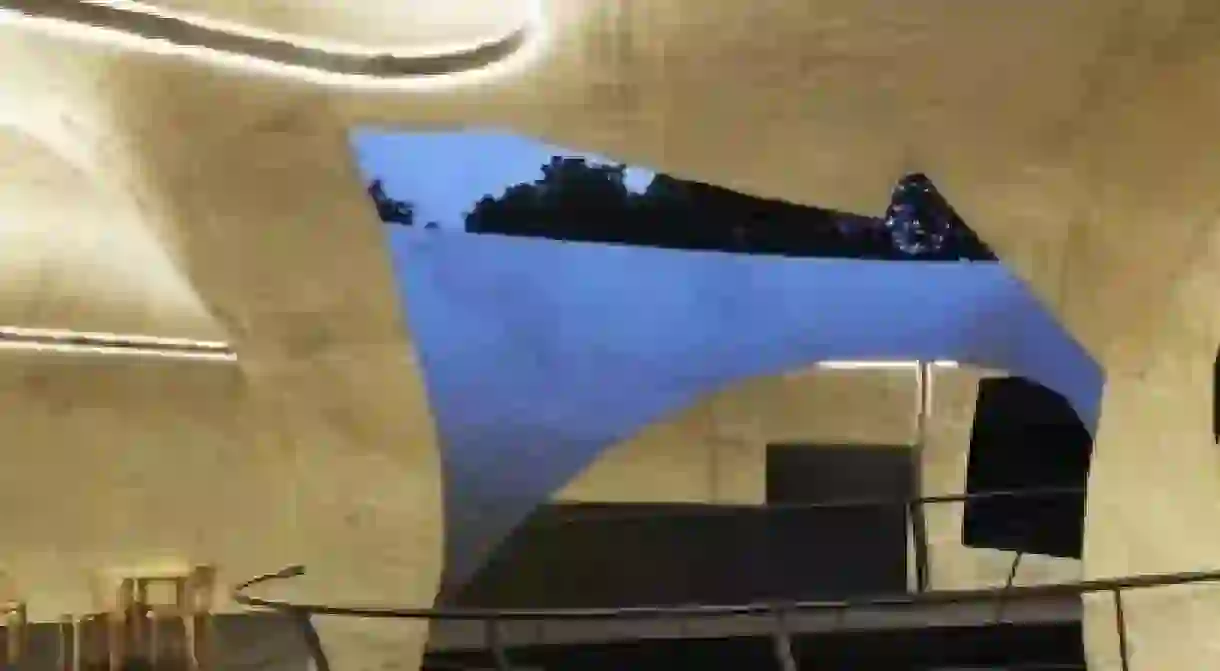Smiljan Radić: The Chilean Architect Going Global

If you haven’t yet heard of Chilean architect Smiljan Radić, that’s likely to change. In 2014 he was commissioned to build Kensington Gardens’ Summer Pavilion, and has since launched into the spotlight.

Nestled in the stillness of London’s Kensington Gardens, Smiljan Radić’s Summer Pavilion looks at home. Shaped like an enormous dun-coloured pebble, the smooth fibreglass mass is carefully broken to create apertures reminiscent of a cracking eggshell. Radić has said that the piece “contains an interior that is organised around an empty patio at ground level, creating the sensation that the entire volume is floating. The simultaneously enclosed and open volumes of the structure explore the relationship between the surrounding Kensington Gardens and the interior of the Pavilion.”
Motivated by a desire to create something both aesthetically brittle but sturdy enough to serve as a public utility, its semi-translucent quality certainly qualifies the former, while its bustling café and public gatherings indubitably serves its aims. Balanced on quarry stones, the Pavilion was closely affiliated with Radić’s former works, “Restaurant Mestizo” and “The Castle of the Selfish Giant,” both of which are similarly the crowning feature of a collection of rocks.

At 350-square meters, the Pavilion dominates the Serpentine’s Lawn, creating a space and hub of social and cultural activity, including the Park Night event series. As one of eight sites participating in this series, Radić situated himself within a temporally current cultural movement that brings together art, film, literature, music and theory.
The four-month tenure that his Pavilion enjoyed in the popular Serpentine has inevitably catapulted Radić into icon status in the United Kingdom. It is unsurprising that the majority of his previous commissions and installations have predominantly been based in his homeland of Chile. His structures range from public commissions like the “Civic Neighbourhoods,” the “Vik Winery,” “Restaurant Mestizo,” as well as personal domestic constructions such as the ‘House for the Poem of the Right Angle, Vilches’ and small, decidedly ephemeral buildings such as the “Extension to Charcoal Burner’s House” in Santa Rosa, and “The Wardrobe and the Mattress” in Tokyo.
Perhaps Radić’s rise to fame has been slowed by his unwillingness to pigeon-hole either himself or his architecture in any particular period, movement or style. Instead, he transcends labels, moving across architectural fields in his mission to prioritise social context, environment and materials. His pieces, therefore, are remarkably heterogeneous, each in dialogue with their surroundings, which is a noteworthy feat when one considers the challenges of the terrain in Chile.

Born in Santiago de Chile in 1965, Radić later studying at the Catholic University of Chile’s School of Architecture and earned his degree in 1989. From there, he worked at the Insitutto di Architettura di Venezia in Italy before returning to Chile. Since the new millennium, Radić’s work has become increasingly recognised across the architectural world. In 2001, he was named “Best Architect Under 35” by the Chile College of Architects, and he has been a lecturer and honorary member of the American Institute of Architects since 2009.
In this capacity, Radić has greater opportunities to express his work, including “The Wardrobe and the Mattress” for which he organised a standalone exhibition in Maison Hermès, Tokyo. The exhibit is divided into installations, photos and drawings. A striking Japanese cedar wood closet is built to a 1mm thickness, and hung with a full-length mirror. On top of the closet, white ropes are used to hang a blood-red mattress, which takes the form of a contorted brain. At this point, it is interesting to consider Radić’s own notions of illustration and construction as a wasteland. He famously remarked, “every good building is the illustration of a passing conviction. It has a civilizing effect on its environs. To illustrate means to civilize, to use the construction of an imaginarium to explain an unattainable state of completeness.”
Although his public presence in the media and interviews is limited, it appears that Radić is fond of quoting inspirational passages and poets, including the great René Char. Indeed, in a reported meeting with José Castillo, Radić commented “to suppress distance is to kill.” It is not only French poets who inform his work and biography, but also his grandfather who came to Chile in 1919 from Brac, Croatia. He has said that “the vision of an immigrant moves between a sense of estrangement from the surrounding world and a need to see things from a productive standpoint; the making of objects, situations, and memories takes on a new, unexpected dynamic. In this way I consider myself an immigrant.”
It is perhaps this problem of self-identification that translates into his work. At times, his buildings appear fragile, overly small, or uneasily situated, notwithstanding their carefully crafted symbiotic relation to their environment. Yet one must caution against too easily drawing affiliations and tensions in his work. Surprisingly, Radić believes that “art and architecture have nothing to do with each other. Their clear difference allows the collaboration between educated architects and artists. This becomes complex […] as a rule, the outcomes of architecture and art collide all over the place.”
Radić is certainly an architect of immense depth of thought and construction. He cites fellow Chilean architect Germán del Sol as a key inspiration, praising his works’ absence of the mannerist, and their celebration of personal character. Radić’s own creations are equally framed by his deep-rooted affiliations with the ‘other’, erosion, and hinterlands: themes that are pervasive to the human experience.













